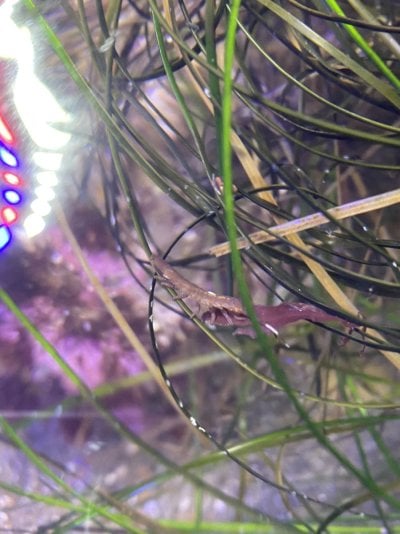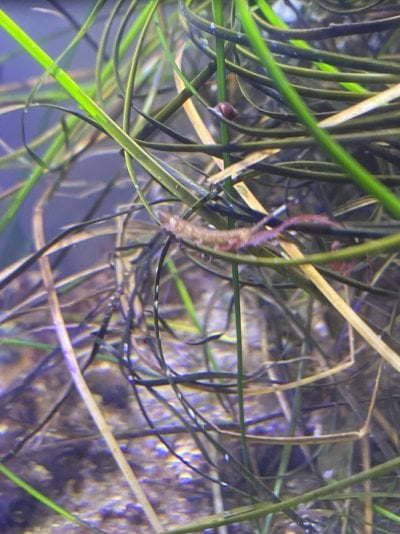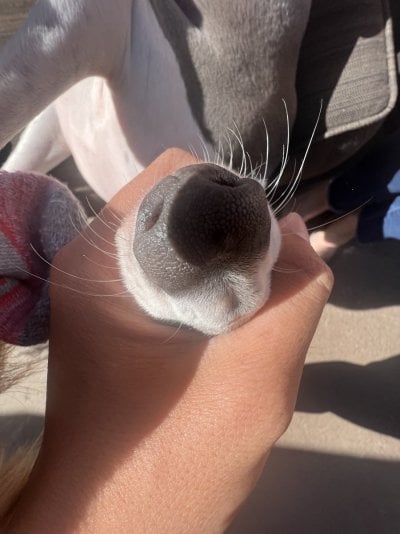Its gonna take me awhile to get through all these. We'll make it a game for every one I don't know you get 1 point, winner gets...Idk I'm poor.
Navigation
Install the app
How to install the app on iOS
Follow along with the video below to see how to install our site as a web app on your home screen.
Note: This feature may not be available in some browsers.
More options
You are using an out of date browser. It may not display this or other websites correctly.
You should upgrade or use an alternative browser.
You should upgrade or use an alternative browser.
Show me some weird animals
- Thread starter BristleWormHater
- Start date
- Tagged users None
Alright, that's a cool frog; I love critters with unusual brooding tactics.the Pipa pipa. Yes those are baby frogs emerging from its back.

Haha, for a bird with that name, I was not expecting something so cute.Oh and how about the satanic nightjar, Eurostopodus diabolicus. The second creepiest of birds named for their cry if I remember correctly.
This reminded of the Ayam Cemani chicken - no fun horn, but they're entirely black with the exceptions of their blood and bones. As an honorable mention for the chicken category (which somewhat surprisingly has a few very interesting breeds), the Serama Bantam is the smallest chicken breed in the world; they're the size of a soda/pop can when full grown, and people sometimes keep them as indoor pets in some parts of the world.The first is of course the horned screamer, Anhima cornuta.
Lungfish are great - super cool how long they can survive without water.The African lungfish, Protopterus annectens, one of my favorites when I lived down there.
Went a watched a video to see the movement there - I feel nauseous just watching it roll, hahaI wish I saw a golden rolling spider though, Carparachne aureoflava. Which moves by cartwheeling!
I don't know which documentary I saw these in, but it is pretty cool watching them glide.Chrysopelea spp are snakes thatflyglide
Slocke
I’m pedantic, ignore me
View Badges

Excellence Award
Reef Tank 365
Photo of the Month
Article Contributor
My Tank Thread
My Aquarium Showcase
Here is from December 2019 in the western Kalahari when going for a critter hunt right after the first rains in probably 6 months. I can’t believe what can survive with practically no standing water. Got one of your triops, an African bull frog, and some other frog with the prettiest eyes.Sorry, I don't have photos; this post is too long as is haha.
Some weird critters:
Longfin damselfish, Stegastes diencaeus - they farm algae and ranch domesticated mysid shrimp.
Hatchet-type mantis shrimp, Acanthosquilla derijardi.
Eusocial Snapping Shrimp species (Synalpheus spp.; Synalpheus regalis is the best known, but there are reportedly a couple other species from the genus which exhibit this behavior as well) - these form ant-like colonies with one reproductive queen and several "workers" in the colony; they also live inside of and defend a home sponge.
Semi-terrestrial Shrimp species (Merguia spp.; M. oligodon and M. rhizophorae) which can climb trees and hop away from danger.
Tonna galea is a very large sea snail that eats sea cucumbers and reportedly leaves a bioluminescent trail.
Yellow-coated Clusterwink, Hinea brasiliana - they have a bioluminescent mantle and a specially designed shell; when they glow (typically glowing when disturbed), their shell diffuses the blue-green light they produce, and their entire shell lights up as a result.
Helmet/Shingle Urchin, Colobocentrotus atratus - this one's pretty straightforward when you see a pic of them.
Swimming Anemones - the best known example in the hobby is Boloceroides mcmurrichi, but there are a few others that swim too.
Shaggy Frogfish, Antennarius hispidus, has a bioluminescent lure, and Hairy Frogfish, Antennarius striatus, has a biofluorescent lure.
Paguritta species are filter-feeding, sessile hermit crabs that live in tubes in corals.
Salps.
Siphonophores.
Fried-egg Jellyfish, Cotylorhiza tuberculata:
"Its sting is so mild that the tentacles sometimes provide shelter to small fish in the open ocean."**
"Sometimes small animals like crabs hitch a ride on top of and inside the jellyfish’s bell, tucked away from the stingers.2"**
**Source:

Fried Egg Jellyfish | Oceana
The fried egg jellyfish, primarily found in the Mediterranean, Adriatic, and Aegean Seas, only lives for about half a year, from summer to winter. Learn more.oceana.org
Longnose Walking Batfish, Ogcocephalus corniger.
Pancake Batfish, Halieutichthys aculeatus.
Fluffy Crab, Lamarckdromia beagle.
Doughboy Scallop, Mimachlamys asperrima - these are known for having sponge grow all over their shell, so you can pretty well only see their mantle (the honestly look kind of like a hamburger).
Trophodiscus species, which are aboral-brooding starfish (they literally brood the baby sea stars on their top-sides).
Glass sponges which build reefs.
Carnivorous tunicates, sponges, and bivalves (mostly/exclusively found in the deep-sea).
Melibe species - predatory nudibranchs with massive mouths.
Male and female deep-sea anglerfish:
"An even more unusual and distinctive characteristic of many anglerfish species is related to their mode of reproduction. The free-swimming tiny male anglerfish can sniff the female’s waterborne pheromones and latch itself onto the female with its sharp teeth. While in some species, male attachment to females occurs temporarily and does not involve fusion of tissues, in other species, the male releases enzymes that dissolve the female’s tissue around his mouth, leading to anatomical joining of the male and female tissues [1]—a naturally occurring form of parabiosis [12] (see Figure 1). Thereafter, the male loses its eyes, fins, and internal organs, except for its testes. Its blood system fuses with that of the female host, and from that point on it receives all its nutrients via the joined circulatory system."*
*Source:

Histocompatibility and Reproduction: Lessons from the Anglerfish
Reproduction in certain deep-sea anglerfishes involves the permanent attachment of dwarf males to much larger females and fusion of their tissues leading to the establishment of a shared circulatory system. This unusual phenomenon of sexual parasitism ...www.ncbi.nlm.nih.gov
(There are a ton of odd deep sea creatures).
Giant isopods (Bathynomus species), giant amphipods (Alicella gigantea), giant copepods (Pennella balaenopterae - a parasite of fin whales), giants ostracods (Gigantocypris species), etc.
Micro-predator and parasitic isopods (the Tongue-eating Louse, Cymothoa exigua, is a great example).
Clam Shrimp.
Tadpole Shrimp (Triops species).
Bagworm Moth (Psychidae) caterpillars.
Junk Bug/Lacewing (Chrysopidae) larvae.
Case-building Caddisfly (Trichoptera) larvae.
Bagheera kiplingi - the herbivorous spider.
Diving Ants, Colobopsis schmitzi - these dive into the digestive fluids of carnivorous pitcher plants to fish out trapped bugs to eat.
Intertidal Ants, Polyrhachis sokolova - these nest in mangroves, and their colonies are completely submerged at high tide; they can swim as needed.
Nomadic Mushroom Harvester Ants, Euprenolepis procera - these literally travel around like army ants foraging for mushrooms to feed on; they're fungivorous.
Honeypot Ants, Myrmecocystus species - these are famous for their repletes, which are ants that basically store food for the colony to survive times of famine; the color of the "Honeypot" replete changes with the color of food/drink fed.
Turtle Ants, Cephalotes species - the soldiers of these ants have flattened, armored heads and literally block the entrances to their nests in the trees with their own heads to control entry/exit.
Striped sheep - yes, these are real, albeit quite rare at the moment.
Frigate Birds (the males in particular).
Sage Grouse (again, particularly the males).
Death-feigning Beetles.
Ant-mimic spiders and beetles.
Okapi.
Alligator Snapping Turtle.
Mata Mata/Matamata Turtle.
Jackson's Chameleon - these have three horns like a triceratops.
Pangolins.
Indicine cattle (Zebu cows).
It's not often that I find out about a new animal, since I grew up reading encyclopedias(I was weird) but I just learned about these guys

Velvet worm
Peripatoides novaezealandiae
I also learned about argonuats or paper nautilus about a month ago

Argonaut
Argonauta argo
If you know ANY weird animals please post them here! We'll see if I know them or not.
These little guys. A type of isopod, Who showed up in my cold water tank a while back.It's not often that I find out about a new animal, since I grew up reading encyclopedias(I was weird) but I just learned about these guys

Velvet worm
Peripatoides novaezealandiae
I also learned about argonuats or paper nautilus about a month ago

Argonaut
Argonauta argo
If you know ANY weird animals please post them here! We'll see if I know them or not.
Attachments
You got one of these in your DT?There is some weird looking deer like creatures in the world




Ah, peripatus. We'd see these in Trinidad when I did field work there in a previous lifetime. They shoot a stream of mucous about two feet at you if you provoke them.
I stuffed one of these. (really)potoo bird?

Solifugid, aka sun scorpion. We get these in the house. Bad as they look, they're not venomous. But they still give me the creeps. They're super fast and can climb the walls.To mimic a camel spider I believe which isn’t a spider but also very weird

Last edited:
Here is from December 2019 in the western Kalahari when going for a critter hunt right after the first rains in probably 6 months. I can’t believe what can survive with practically no standing water. Got one of your triops, an African bull frog, and some other frog with the prettiest eyes.



Last edited:
LOL


Those are neat looking!Pterotracheoidea super family sea slugs are neat. They're pelagic predators, some of them have incredible eye sight for gastropods, up there with conchs, if not better.
Similar threads
- Replies
- 5
- Views
- 86
- Replies
- 3
- Views
- 86
- Replies
- 10
- Views
- 363



















